The road was rough and I found myself riding the centre line pretty tight as traffic would allow.
The morning started off very cold and overcast but the farther north I went the more the sun began to appear.
I rode alongside the Dildo Run Provincial Park and giggled, like everyone else does, at the name.
In researching the history of the name, I found out, through Wikipedia, that the name dates back to 1711 as the first known use. The name used to be spelled "Dildoe". It is thought that Captain James Cook and his assistant Michael Lane may have given the region it's name. Apparently they had a notoriously wicked sense of humour about naming the communities and regions they mapped.
Although the road is rough, that actually provides an opportunity, when traffic allows, to take it nice and slow and really take in all of this rugged, wild beauty. Just by looking at the terrain, you know that you have to be made of tough stuff to thrive here.
I slowed and took my time riding into the town of Twillingate attempting to capture a little of the beauty on film. This place is home to many icebergs and iceberg tours, so many in fact that it is called the Iceberg Capital of Canada. There were no icebergs for me to see, however a member of our staff, Stephanie, is from Newfoundland and was at home visiting earlier in the year and was able to provide me with more than a few great photos to compliment our video with!
Twillingate is located in the Twillingate Islands and is joined to mainland Newfoundland by the New World Island Causeway. It's history is a rich one and a number of famous people have come from this small community of approximately 2,500.
One of them, Georgina Sterling was a prima donna soprano opera singer who went by the stage name of Marie Toulinquet and later became known as the Nightengale of the North.
After fuelling up I headed back down the 340 Route, I wanted to stop in Boyd's Cove and see the Beothuk Interpretation Centre.
The Twillingate Islands region, has a history of bloodshed and fighting that can not be ignored or forgotten.
The Beothuk people who inhabited this region can be traced back to the 1,500's and are thought to have originated as a branch of the Algonquin nation and are have thought to have migrated here from Labrador.
During spring, the Beothuk used red ochre to paint their bodies, houses, canoes, weapons, household appliances and musical instruments with. This Europeans, because of this tradition, referred to them as "Red Indians". For the Beothuk, the use of red ochre as paint designated tribal identity; decorating newborn children was the way they were welcomed into the tribe. Forbidding a person to wear the red ochre was a form of punishment.
Due to the arrival of the Europeans, the settling of the Mi'kmaq and Inuits, the Beothuk peoples found it hard to thrive. They began a campaign of violence in retaliation and that factored into their demise as a nation. Along with Tuberculosis and other infectious disease brought to the new world by the Europeans and the loss of so much of the land they had used to survive on, the Beothuk peoples became listed as officially extinct in 1829.
On of the most famous of all the Beothuk people is a woman named Mary March. The provincial museum is named for her. She was captured during a raid in March of 1819 at the approximate age of 23, when John Peyton Jr. and his men went to retrieve a fishing boat that had been stolen by the Beothuk. She had been nursing a baby boy who died a few days after the raid, her husband was killed in the raid. Her Beothuk name was Demasduit, but a Church of England priest, the Reverend John Leigh renamed her to Mary, after the Virgin Mary and March for the month in which she was captured/kidnapped from her people.
It was hoped that Mary March, who had taught members of the St John's community, where she had been taken after a brief time in Twillingate, to speak about 200 words of the Beothuk language would one day be the person to build a bridge between the Europens and the Beothuk but she died of tuberculosis in January of 1820. At the time of her death there were thought to be only 31 Beothuk left.
 |
| Shanawdithit - the last of the Boethuk |
Her niece, Shanawdithit died in 1829 and as she was the last of the Beothuk, her nation died with her.
As much as I have travelled this country, everytime I travel Canada, I learn more about our history, heritages and cultures.
It was time to get back on the bike and head to Newtown.
As I got closer to Newtown, the wind picked up. It was a cold wind too, but at least the sun was still out!
To find out more about the Beothuk Interpretation Centre visit:
http://www.seethesites.ca/the-sites/beothuk-interpretation-centre.aspx
I went into the visitor information centre and was directed to have some
lunch (a late one) and that when I was done, Cheryl would be my guide.
 |
| Barbour Living Heritage Village |
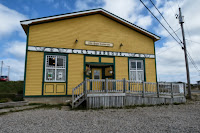 |
| Olde Shoppe Restaurant |
The place is filled with antiques and wonderful aromas and I was some hungry!
Since I had determined I liked Cod Tongues, that's what I ordered.
With a full belly and a mind that could now concentrate again, I headed back to the visitor information centre/gift shop and found Cheryl.
 |
 |
| Cheryl taking me to the Bejamin Barbour House to begin our tour |
Captain Benjamin Barbour and his family of nine sons and two daughters called this house, home. Benjamin had moved to Newtown from Cobbler's Island in 1873. Up until moving into the new home in 1875, the family lived in a log house not far away. He passed away in 1891.
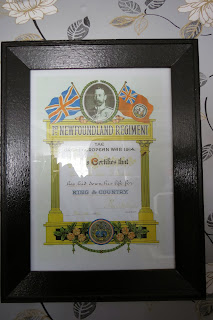 Two of Benjamin's sons, Edward and Samuel started E & S Barbour. Edward's son Lester who had being groomed to take his father's place in the business died during the first world war in as a member of the 1st Newfoundland Regiment. He had left Newtown for Europe in May of 1917. He died 10 months later, at the age of 23, during the German counter-offensive at Paschendale Ridge, Belgium on March 10th, 1918. He was buried at the Oxford Cemetery, near Ypres, Belgium.
Two of Benjamin's sons, Edward and Samuel started E & S Barbour. Edward's son Lester who had being groomed to take his father's place in the business died during the first world war in as a member of the 1st Newfoundland Regiment. He had left Newtown for Europe in May of 1917. He died 10 months later, at the age of 23, during the German counter-offensive at Paschendale Ridge, Belgium on March 10th, 1918. He was buried at the Oxford Cemetery, near Ypres, Belgium.
The Benjamin Barbour House is an unusual home no matter how normal it looks from the outside.
You see there are 32 rooms inside, including 2 living rooms, 2 kitchens, 12 bedrooms, 2 staircases and two front doors. The house had been constructed in this manner to become the home to two of the brothers, and everything could have been closed up into what we call today a duplex, had the families not gotten along.
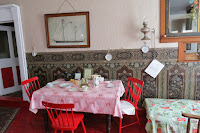 |
 |
| The main kitchen with two beds for the men to take afternoon naps in! |
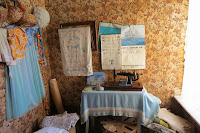 |
| The sewing room |
 |
 |
| Dining Area |
 |
| Stuffs On table |
Cheryl took me upstairs via on of the two staircases, it wouldn't have mattered which one we took as there is no wall between the two upstairs!
 |
| Two staircases were built to two seperate appartments in the Barbour Home, this way a wall could be built if the two families could not get along together. |
A few of the many bedrooms
 |
| Another Parlor |
 |
| My Bedroom |
Running water in the back entry of the house
Cheryl proved to be a wealth of knowledge and shared numerous stories of the Benjamin Barbour family, she told me of Job Barbour a sealing captain who wrote a book called "Fourty-Eight Days a Drift" and of the family members who still visit Newtown and the Barbour Village.
She told the stories in such a way that you felt you could hear the laughter of children as they ran through the house and that you could feel the pain of the women who lived here as their loved ones died at sea or in war.
The E & S Barbour & Sons "Store" - the Waterfront Premises & Neptune II Theatre- is an auditorium where there are plays held during the summer depicting life of the region. It has also seen community meetings and weddings be held here.
 |
| Weddings and other meetings are held here |
 |
| Amazing art and historical photos grace the walls |
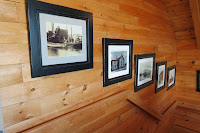 |
| Arts on walls |
 |
Cheryl took me to the Alphaeus Barbour home next, WHAT A PLACE!

Captain Alphaeus Barbour was one of Benjamin Barbour's grandsons and this house was built for him. He later sold it to Samuel Barbour (1925) and in 1933, the Cape Freels Heritage Trust bought it.
This house had running water, hot and cold running water, it also boasted stain glass windows, dormers and an opulence normally reserved for the bigger centers like St. John's.
 |
| An ornate pump organ |
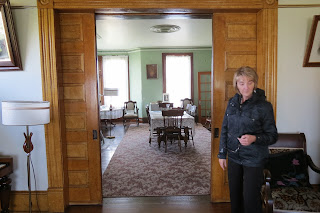 |
| Cheryl explains that the dining room could be made private with the sliding doors |
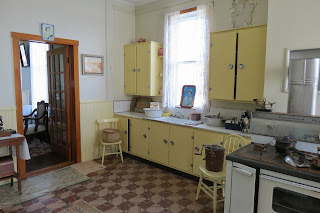 |
| A very well appointed kitchen |
 |
| The pantry |
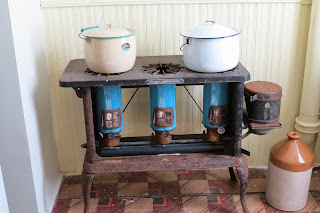 |
| One of the first oil stoves |
 |
| Dining Area |
 |
| A magnificent stairway leads you upstairs. The workmanship is stunning. |
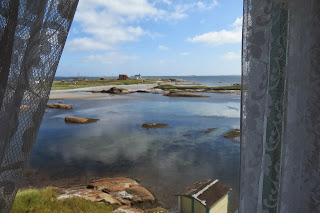 |
| The view from the master bedroom |
 |
| The nursery |
 |
| One of the very few homes to have hot and cold running water, the Barbour home also boasted a beautiful claw-foot tub. |
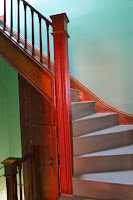 |
| The stairs to the servants quarters |
As work maintaining the property is ongoing, I was not permitted upstairs.
The next and possibly most fascinating part of this tour involved the Sealers Interpretation Centre.
Now my visit here came at a bad time as all of the students who act out the roles of the various people who lived here were already gone. The funding for these types of jobs had been cut, shortening the length of time which the theatrical encounters can take place.
Again, Cheryl did an amazing job of explaining the history of sealing and answering my questions about the various artifacts and displays.

As you go to the Interpretive Centre, one of the first things you see as you pass by is this monument to Gary Brazil.

As you go to the Interpretive Centre, one of the first things you see as you pass by is this monument to Gary Brazil.
Inside the Sealer's Interpretive Centre:
Back inside the main body of the centre, there are numerous glassed displays with models and other artifacts depicting the history of the sealers.
Sealing has a deep entrenchment in the history of Newfoundlanders as Cheryl explained to me.
During the 1,500’s migratory fisherman began hunting the harp seal and the indigenous peoples have hunted the harp seal as back as 4000 years ago.
Seals provided the early settlers with much needed meat during a time of year when they would be surviving off of their stored foods.
The fishermen of Europe were the first to hunt seals for economic gain. The oil and the pelts were highly prized in Europe. The oil was used for lanterns, as cooking oil and in the production of soap as well as in the preparation of leather for the creation of leather goods.
Despite the modern day controversy over sealing, Newfoundlanders acknowledge and embrace their history and heritage and celebrate it in an almost deprecating way.
Sealing brought food and in some cases wealth to Newfoundlanders but it also brought much heartache as well. The ice that can pack up on the ocean in the winter trapped many sealing ships and many a sailor lost his life in the quest of food, wealth or both.
This centre brings the history of the sealer to life. It documents the tragedy and the triumph of the Newfoundlander and their spirit.
 |
| One of many scale models of ships from days gone by. |
 |
 |
| A replica ship, built indoors, everything is 1/4 scale or so and there are two floors! The deck and the quarters. |
 |
| Inside the belly of the ship |
 |
| The galley |
 |
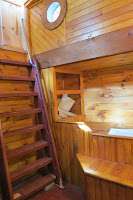 |
| The captains quarters |
Sealing has a deep entrenchment in the history of Newfoundlanders as Cheryl explained to me.
During the 1,500’s migratory fisherman began hunting the harp seal and the indigenous peoples have hunted the harp seal as back as 4000 years ago.
Seals provided the early settlers with much needed meat during a time of year when they would be surviving off of their stored foods.
The fishermen of Europe were the first to hunt seals for economic gain. The oil and the pelts were highly prized in Europe. The oil was used for lanterns, as cooking oil and in the production of soap as well as in the preparation of leather for the creation of leather goods.
Despite the modern day controversy over sealing, Newfoundlanders acknowledge and embrace their history and heritage and celebrate it in an almost deprecating way.
Sealing brought food and in some cases wealth to Newfoundlanders but it also brought much heartache as well. The ice that can pack up on the ocean in the winter trapped many sealing ships and many a sailor lost his life in the quest of food, wealth or both.
This centre brings the history of the sealer to life. It documents the tragedy and the triumph of the Newfoundlander and their spirit.
The history of sealing and the evolution of it, is woven deeply into the fabric of Newfoundland's rich and storied history. The Sealer's Interpretive Centre is an amazingly frank look at the industry, its history and its role in shaping the people of Newfoundland.
The Methodist Schoolhouse was the last building we would visit on this tour. Filled with artifacts from the region, this schoolhouse is very much like the one room schoolhouses that were all over rural Canada in the day.
 |
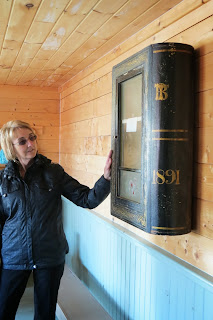 |
| Cheryl's great grandfather, a master carpenter, had made the glass curio cabinet that looks like a bible. |
You see, it truly takes a local to do a credible job of telling the stories and history of a region and Cheryl, born and raised here, was able to share so many wonderful little tid bits and information and I thank her deeply for sharing the stories and history of the region with me. The tour will cost you $10 for adults and $20 for a family. It will be some of the best money on a tour you will ever spend.

The Barbour Heritage Village in Newtown is a MUST DO when you find yourself in the Adventure Heart of Newfoundland. For more on Central Newfoundland visit: www.centralnewfoundland.com
For more information on the Barbour Living Heritage Village in Newton NL visit:
To book a tour call: (709) 536-3220 or Fax (709) 536-3150.
The day was getting away from me, I headed towards Norton Cove Studio in Brookefield and Greenspond and the Harding House B & B where I would be staying for the night.
I had wanted to stop into the studio, but by the time I got there it was too late in the day for me.
It was cold and bitterly windy, and the Courthouse in Greenspond was not supposed to be closing until 6pm.
I would not be able to do justice to the art of Janice Davis at Norton's Cove Studios if I could only spend a 1/2 hour.
So I kept on towards Greenspond as I was a good 40 - 45 minutes away and it was now 4:30 pm.
As fate would have it, I got to Greenspond only to find the Courthouse Museum closed early and I was out of fuel - and Greenspond does not have a gas station! I got lucky though. I talked to a lady at the fishery and her husband had some gas that he'd deliver to me at 8:30 in the morning!
It's amazing how unpanicked I felt about the gas. I was more upset that I had not taken the time to visit the art studio. With nothing else to do, I went and got checked in at the Harding House B & B.
This beautiful old home has been transformed into a very modern B & B without loosing any of its charm. The current owner, Abigail Crocker is a wonderful hostess.
I got to the back door of the B & B and there she was, waiting on the back porch to greet me.
I felt like I was visiting the house of a long lost friend.
This very engaging woman has done a lot of work to this historical home, updated electrical, bathrooms, plaster board - the entire thing is up to code and yet, you still feel like you are in a turn of the century home.
After I got my gear settled in my room, I went to the kitchen to join Gail.
I insisted that I would feel more comfortable in her kitchen than anywhere else in the house.
She made some coffee and explained the history of the Harding House to me.
Harding House was built for Edward Harding in the 1890’s.
Edward had one daughter, who married a man named James Dominy who tragically drowned shortly after their
His widow moved to St. John's and the house was rented for several years to the Newfoundland government for use as a dwelling for the local magistrate.
Early in the 20th century, Thomas Harding bought the house and raised his family there.
Thomas’s wife’s name had incidentally been Abigail!
Built of wood timber construction and featuring a steep gable roof with double bay windows, this home retains its original wood shingles on the peaks above the bay windows as well as some of the decorative bracket work on the front facade and the windows are also original to the home. It is a wonderful representation of the homes in the region at the turn of the century.
Tom Harding's three grandsons, Harry, Fraser and Rick, sold the house in 2002 to Gail Crocker.
On September 7th of 2002 the Heritage Foundation of Newfoundland and Labrador designated Harding House as a Registered Heritage Structure.
Gail is very proud of the work she has done to keep the Harding House feeling like a home and so she should be.
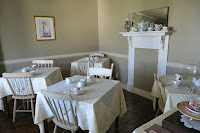 |
| Abigail's Tea Room |
 |
| The Living room |
 |
 |
| One of the 4 rooms in this house |
 |
| 2 rooms have private baths and two rooms share a bath, this bath is for the room in the above photo. |
 |
| My room had a private bath and a beautiful dormer window to look out over the bay! |
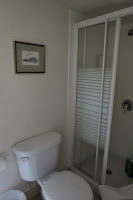 |
| The bath in my room |
 |
| Abigail busy in her spotless kitchen |
Gail is also a very talented cook with a gift for gauging her guests and their needs well.
She can be as open and warm or as "distant" as the guest would like her to be.
After an amazingly delicious dinner of cod, fresh vegetables, potatoes and a bun, I was served one of Gail's famous scones. In fact, she shares her recipe on her web site so whenever I want to, I can make some, have a coffee and daydream about my time in Greenspond and getting to know Abigail, I so identified with her spirit of determination.
Gail called the gentleman who is the town administrator and got me an appointment to see the Greenspond Courthouse for 9 am. It normally doesn't open until 10am.
I was tickled at the opportunity to see this very historic courthouse!
After a bed time cup of tea and another scone, it was time to get some sleep.
I slept peacefully in the beautiful room with the amazing view, a smile dancing on my face I am sure.
It had been a fabulous day and I truly felt like I was beginning to know Newfoundland and it's people.
To find out more about the Harding House Bed & Breakfast visit:
www.thehardinghouse.com
It had been a fabulous day and I truly felt like I was beginning to know Newfoundland and it's people.
To find out more about the Harding House Bed & Breakfast visit:
www.thehardinghouse.com
Until next time...
Ride safe!
Belt Drive Betty
Editor & Rider
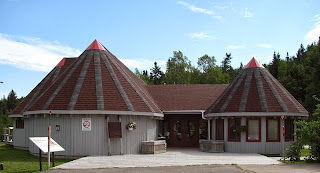























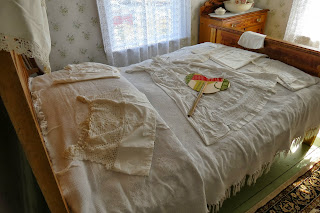


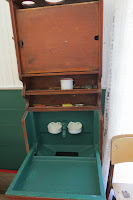





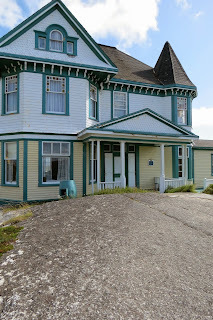


















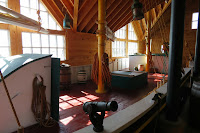



























No comments:
Post a Comment